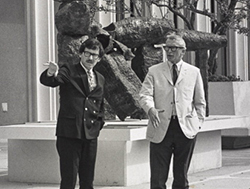Maurice Tuchman Archive
Maurice Tuchman papers, 1949–1998, undated
One of the most important curators to emerge from Los Angeles, Maurice Tuchman (b. 1936) helped shape the identity of the Los Angeles County Museum of Art (LACMA) through his many exhibitions and projects, including the historic Art and Technology exhibition of 1971. His archive features correspondence, press clippings, photography, audiovisual recordings, publications, personal papers, and even his appointment books from the beginning of his tenure at LACMA until the 1980s.
Tuchman received his master's degree in art history from Columbia University, studying under Meyer Schapiro alongside artist Donald Judd, art critic Barbara Rose, and former MoMA Director William Rubin as fellow students. In 1964 he became LACMA's first full-time curator of modern art. Tuchman inaugurated his tenure with the exhibition New York School: The First Generation (1965), followed by Five Younger Los Angeles Artists: Tony Berlant, Melvin Edwards, Llyn Foulkes, Lloyd Hamrol, Philip Rich (1965), and Edward Kienholz (1966). In 1967 Tuchman launched the landmark Art and Technology initiative, pairing artists such as Claes Oldenburg, Richard Serra, and Andy Warhol with local industrial and research partners—Disneyland, Lockheed Martin, and the Rand Corporation among them—to produce cross-disciplinary experimentation. The project resulted in two exhibitions, one at Expo '70 in Osaka (1970) and the other at LACMA (1971). It also spurred the subsequent Light and Space work of artists James Turrell and Robert Irwin, whose collaboration with psychologist Ed Wortz on a Ganzfeld installation definitively altered the course of all three. Art and Technology arguably remains LACMA's best-known exhibition, both for its ambition and scale—more than 70 artists were invited to participate—and for the ensuing controversy over its exclusion of women artists (which ironically helped catalyze the feminist art movement in Los Angeles). The episode suggests the degree to which the museum's history and identity was shaped by Tuchman, especially in the early years. In addition to the exhibitions that he curated or co-curated, including American Sculpture of the Sixties (1967), The Avant-Garde in Russia, 1910–30: New Perspectives (1980), The Spiritual in Art (1986) and Parallel Visions: Modern Artists and Outsider Art (1992), Tuchman's legacy can be seen in the permanent collection that he helped establish and in the curators who he brought on, including Stephanie Barron, Carol Eliel, Howard Fox, and Jane Livingston. Outside his work at the museum, Tuchman prepared the catalogue raisonné for Russian painter Chaïm Soutine. The archive complements papers already in the Special Collections of the Research Institute, including those of Lawrence Alloway, Betty Asher (his former assistant at LACMA), Henry Hopkins (his former colleague), and Barbara Rose (his former classmate), as well as the records of the Experiments in Art and Technology Los Angeles group. | ||||||
